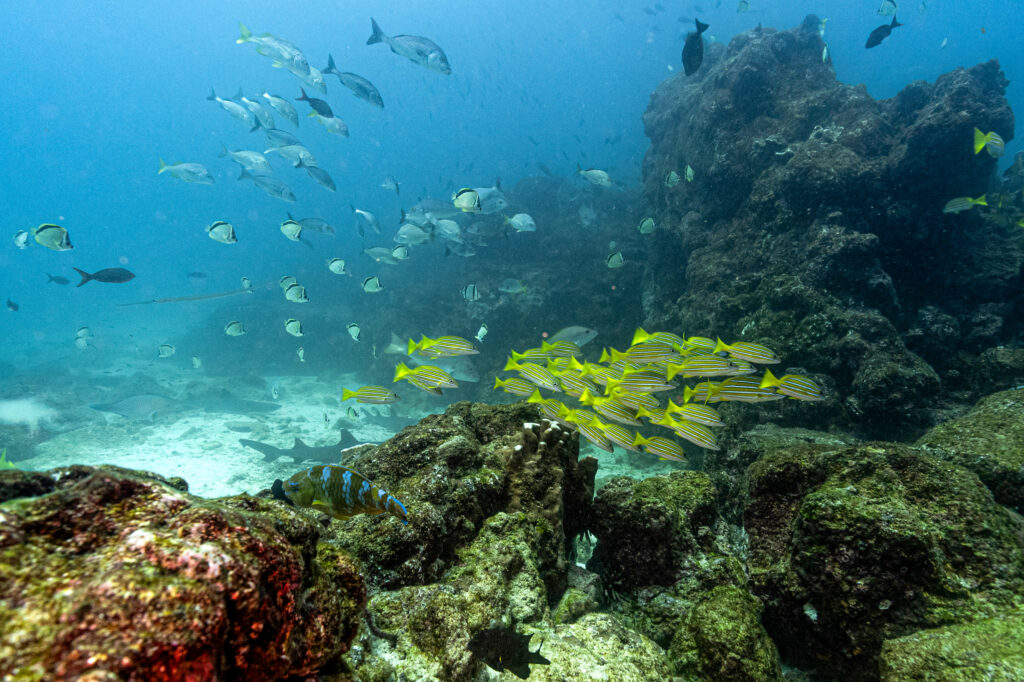
In a milestone for ocean governance and conservation, the High Seas Treaty has cleared the final hurdle to become international law, which for the first time provides a legal pathway towards protecting vast areas of the global ocean beyond countries’ national jurisdictions.
Last week, Sierra Leone and Morocco ratified the treaty—formally known as the Agreement under the United Nations Convention on the Law of the Sea on the Conservation and Sustainable Use of Marine Biological Diversity of Areas Beyond National Jurisdiction (or BBNJ Agreement)—signaling their commitment to abide by its terms. Their actions, along with those of dozens of other nations, have pushed the pact past the 60-country threshold required to become a legally binding instrument, which will go into effect in January.
“This historic moment is the culmination of years of dedication and global diplomacy by governments and stakeholders,” said Rebecca Hubbard, director of the High Seas Alliance, a coalition of more than 70 non-governmental organizations that advocate for the protection of international waters and the important marine ecosystems found there. “The High Seas Treaty is a powerful testament to multilateralism, showing what the world can achieve when we come together for the common good for our ocean, which covers more than 70 percent of the planet,” she said in a statement.
The U.S. has not yet ratified the treaty, though it has indicated its support by signing the agreement, according to the U.S. State Department. Countries that ratify the treaty formally commit to being legally bound by its articles and provisions.
Inside Climate News spoke with Nichola Clark, senior officer at the Pew Charitable Trusts, who has spent the last ten years leading the nonprofit’s advocacy work related to the BBNJ treaty as part of the organization’s campaign to improve ocean governance to protect both marine ecosystems and human health and livelihoods. Below, Clark unpacks the importance of this agreement and its implications for marine life in two-thirds of the ocean.
This interview has been edited for length and clarity.
TERESA TOMASSONI: The High Seas Treaty has just crossed the crucial ratification threshold to enter into force. What does that milestone mean and why is it being described as a historic turning point for the ocean?
NICHOLA CLARK: For the first time, this treaty provides a pathway for all countries that have ratified it to participate in the governance and protection of important ecosystems in international waters.
In 2023, when the treaty text was adopted by U.N. member states after around 20 years of negotiations, ocean advocates celebrated. Many thought the world would never reach consensus on protecting the high seas. It was a once-in-a-generation moment. But adoption only created a document—it was still hypothetical. For it to actually become a real living, breathing agreement that was international law, there was a requirement that at least 60 countries had to formally ratify it. For the last two years, we’ve been racing to acquire those ratifications. Some diplomats and even academic papers predicted it could take five years or more to get the necessary ratifications. The U.N. Convention on the Law of the Sea, for instance, took years and years before it entered into force.
TOMASONI: What is the High Seas Treaty and why is it important?
CLARK: This agreement, which will become international law next year, applies to parts of the ocean referred to as the high seas that lie beyond countries’ exclusive economic zones (EEZs). These are maritime areas established by the United Nations Convention on the Law of the Sea (UNCLOS), that recognize countries’ sovereign rights to explore, exploit, conserve and manage natural resources within 200 nautical miles from a country’s coast.
TOMASSONI: Why do the high seas need protection?
These areas are quite far physically, and they’re far from our minds. But they are absolutely central to the biodiversity and ecosystems that we all rely on. A lot of marine life, especially highly migratory animals like whales, sea turtles and commercially valuable fish stocks, transit through high seas areas. Many seabirds spend most of their lives out there. It’s great and important to protect these animals and their habitats in domestic waters where we can, but if you really want to protect them throughout their life cycle and where they live and spend their lives, we have to protect them beyond countries’ 200-mile line exclusive economic zone boundaries.
Illegal, underreported and overfishing continue to pose great threats to biodiversity in these areas. Climate change is warming and acidifying the ocean, shifting entire ecosystems. Around 90 percent of commercial shipping also happens across the high seas. Ship waste, pollution and carbon emissions all affect ocean health. There’s also potentially emerging threats. Commercial deep-seabed mining is not yet taking place on a commercial scale. But if that were to begin, you could anticipate that being a major threat to high seas biodiversity.
TOMASSONI: How does this treaty help address some of these threats?
CLARK: The treaty has four main pillars. It allows countries to establish marine protected areas (MPAs) in the high seas. It requires stronger environmental impact assessments for activities there. It creates a system for sharing benefits from marine genetic resources. And it ensures support for developing countries to participate through technology transfer and capacity building.
The treaty creates a process through which countries can develop and propose high seas marine protected areas. These proposals would then be reviewed by a new scientific and technical body created as per the BBNJ agreement, which could decide whether to adopt it.
Marine protected areas on the high seas could act as sort of refuges for different animals in a rapidly changing environment. They could also help protect certain species that are more resilient to climate change, which could then help with recovery in other places from climate change. We know migratory pathways for some animals are also shifting due to climate change. This treaty offers an opportunity to potentially create flexible, well-connected areas of protection that are going to make the biggest impact on the lives of marine organisms and ecosystems as the ocean changes and as their habitats change.
The protections themselves can vary. Some countries interpret the treaty to mean the BBNJ Conference of the Parties (COP) can make legally binding rules. For example, if you’re a party to BBNJ, it could be argued that your country could not fish in a high seas MPA. Others think it just means the COP makes recommendations to other governing bodies like Regional Fisheries Management Organizations (RFMOS), which establish regulations for the conservation and sustainable management of fish stocks, or the International Seabed Authority, which controls all mineral-resources-related activities in international waters. The treaty language is deliberately ambiguous, and how it’s interpreted will be one of the first big debates at the BBNJ’s first COP meeting, which we anticipate will happen next year.
This story is funded by readers like you.
Our nonprofit newsroom provides award-winning climate coverage free of charge and advertising. We rely on donations from readers like you to keep going. Please donate now to support our work.
Donate Now
TOMASSONI: Can you tell me more about some of the other key components of this treaty?
CLARK: It also promotes the use of environmental impact assessments to ensure there is better accountability for activities happening on the high seas. Countries that have ratified the treaty will be required to complete these assessments before pursuing activities on the high seas to demonstrate they won’t cause irrevocable harm to the biodiversity that’s there.
It also has some really cool provisions that have the potential to dramatically advance global equity. For example, the treaty requires countries to develop processes that will ensure that the benefits derived from marine genetic resources discovered on the high seas be shared with the global community. Let’s say hypothetically, the cure for cancer is found in some sponge that’s only in the high seas. Right now, only a handful of countries can actually afford to conduct research in these areas or invest in the pharmaceutical industry that would actually produce the drugs that would cure cancer.
The treaty requires ratifying countries, develop a mechanism to equally share the benefits of such a discovery, be it monetary or other, with developing countries.
TOMASSONI: What are some high seas areas that countries want to protect once the treaty goes into effect?
CLARK: There are several countries working in collaboration with scientists to develop a proposal to protect the Costa Rica Thermal Dome. This area in the Eastern Tropical Pacific is known as a dynamic upwelling zone, where powerful winds and ocean currents push warm surface waters away, which are then replaced by cooler deep ocean waters. These waters are full of vital nutrients that fuel massive phytoplankton blooms. This then feeds zooplankton, which many marine animals depend on. It’s an incredibly productive area—tuna, dolphins, sharks, whales, turtles, seabirds all gather there to feed. It also moves with ocean conditions, so it could be one of the first examples of a “dynamic” protected area, meaning its protections would follow its movements.
The Sargasso Sea, sometimes referred to as a “floating rainforest,” in the North Atlantic, is another area. It’s renowned for its vast floating mats of sargassum seaweed, which provides critical habitat for juvenile sea turtles. It’s also a spawning ground for endangered European and American eels, and an important feeding ground for many other marine animals. Chile is in the process of developing a proposal to protect a long chain of underwater mountains off Chile and Peru called the Salas y Gómez and Nazca ridges. This area is known to have deep-sea coral reefs, sponges and lots of endemic species.
These are just some of the biodiversity hotspots in the high seas that have been identified for years, but until now, there was no legal mechanism to protect them. Now there is.
TOMASSONI: Looking ahead, what comes next?
CLARK: The next step probably is the hardest step, which is implementing the agreement—turning this treaty into actual protections for the ocean. We also need to keep momentum on ratification. Sixty ratifications allows the law to go into effect, but the ultimate goal is universal ratification.



